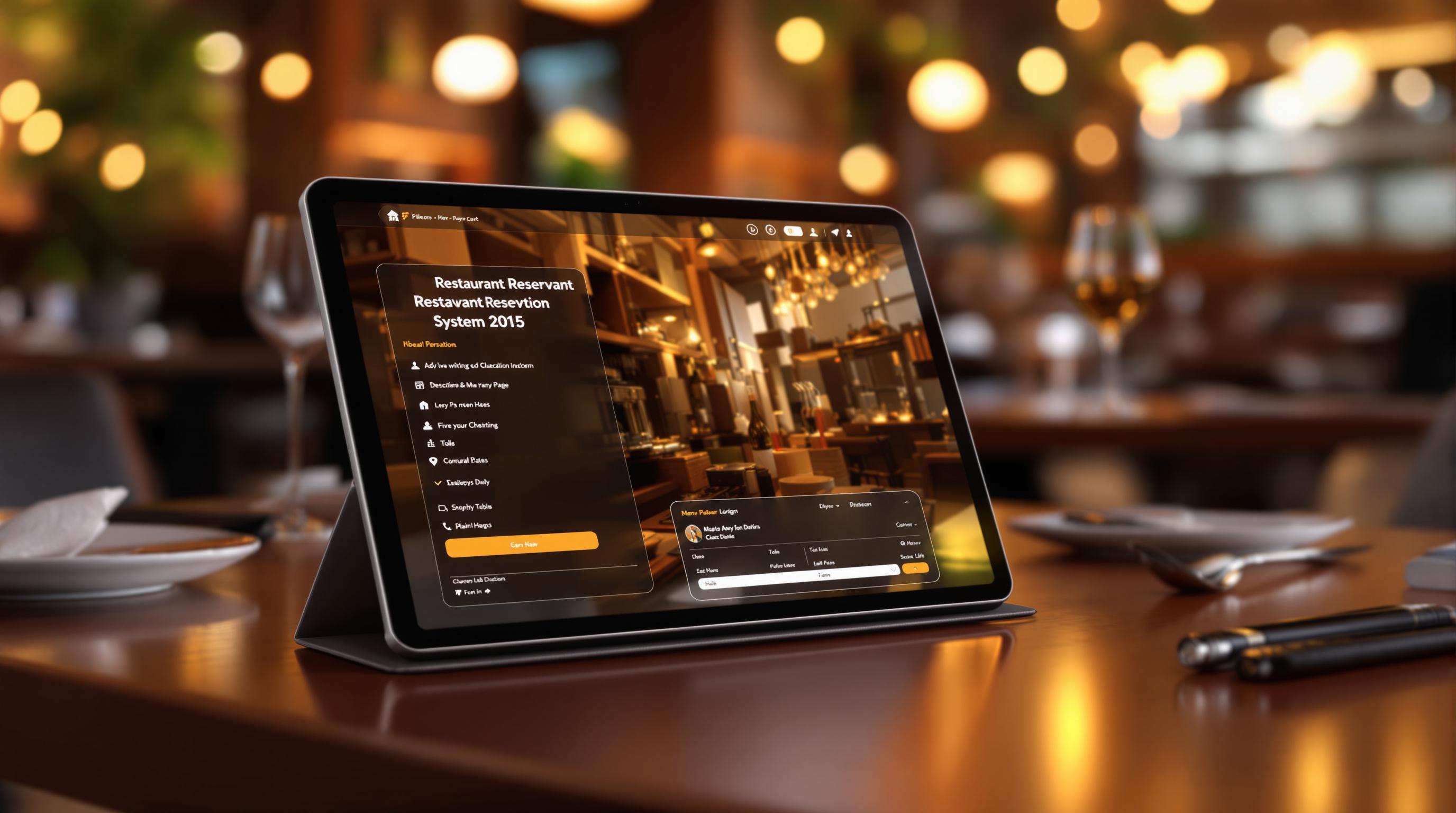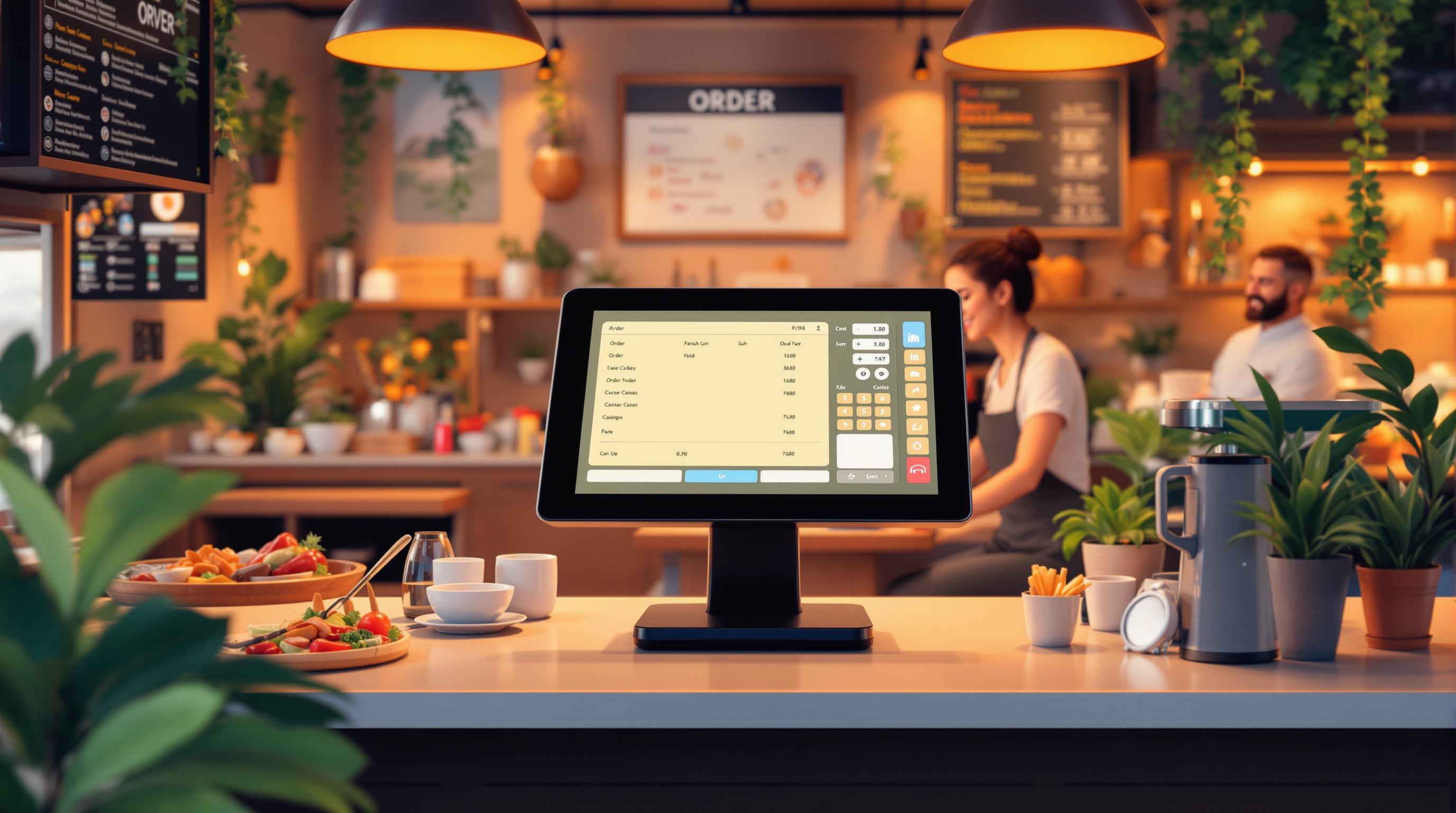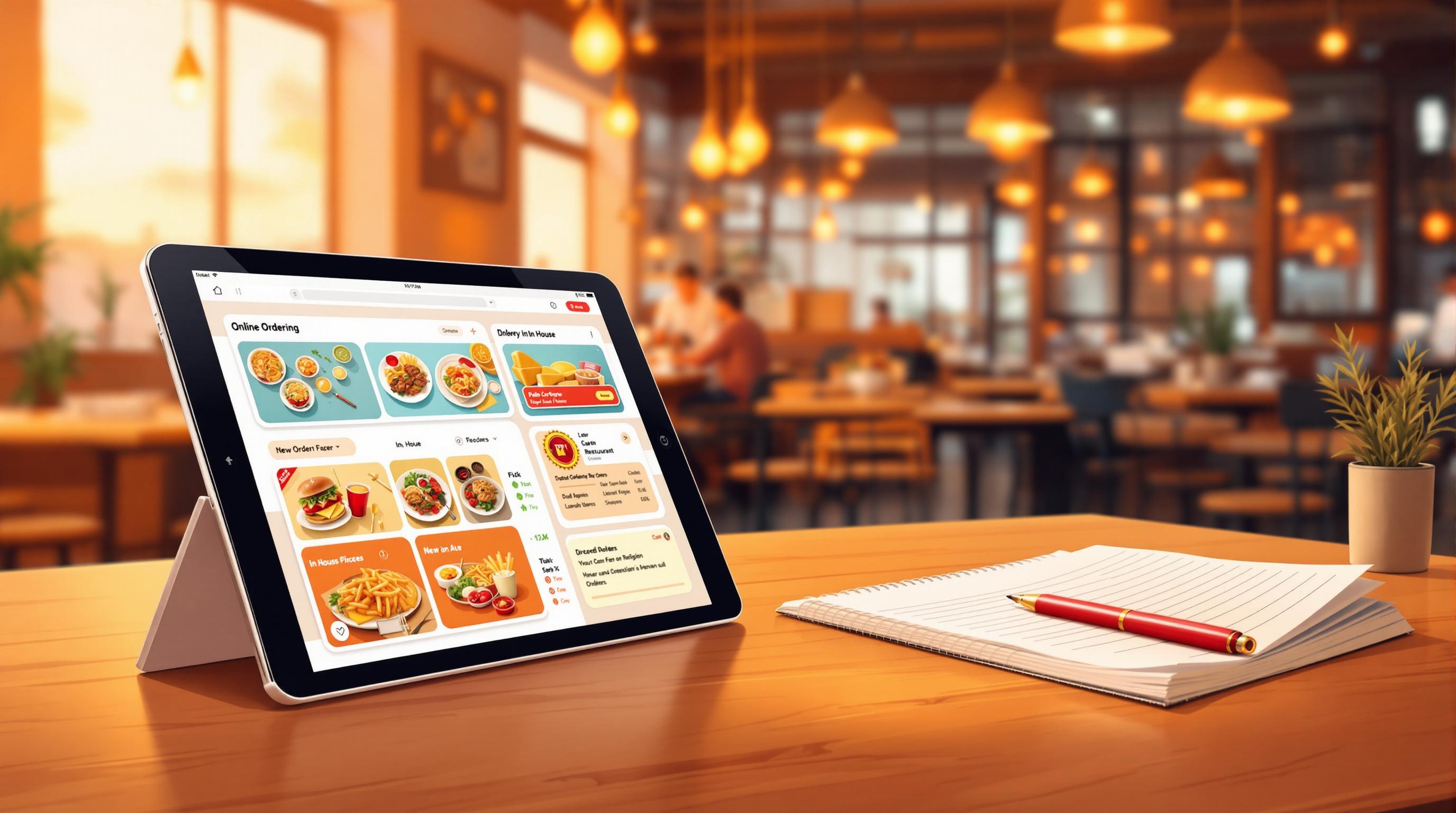Running a restaurant isn’t just about food - it’s about using the right tools to manage operations efficiently. Here's a quick guide to the must-have software for new restaurant owners:
- POS Systems: Manage orders, track sales, and process payments (e.g., Toast, Square).
- Inventory Management: Control stock, reduce waste, and track costs (e.g., MarketMan, WISK).
- Online Ordering: Handle direct orders and deliveries without third-party apps (e.g., BentoBox, GloriaFood).
- Staff Scheduling: Simplify team scheduling and payroll (e.g., 7shifts, Sling).
- CRM Tools: Build loyalty and personalize customer engagement (e.g., Toast CRM).
Key Tips:
- Choose tools that integrate well to avoid juggling multiple systems.
- Start with essential software, then expand as your business grows.
- Prioritize user-friendly, scalable options with strong customer support.
Investing in the right software can save time, reduce errors, and improve your restaurant’s efficiency from day one.
Types of Software Every Restaurant Needs
POS Systems: Managing Sales and Orders
Tools like Toast and Square help simplify daily tasks and reduce mistakes, especially during peak hours. Their features include:
- Real-time sales tracking to monitor performance.
- Inventory integration to keep stock in check.
- Table and floor management for smoother service.
- Kitchen display system connections to streamline orders.
- Secure payment processing for peace of mind.
Inventory Management Software
Programs such as MarketMan and WISK help you maintain the right stock levels, avoiding over-ordering and cutting down on food waste. Features include:
- Automated ordering to save time.
- Real-time food cost tracking to manage expenses.
- Vendor management for smoother supplier coordination.
- Recipe costing tools to calculate dish profitability.
- Waste tracking for better resource management.
Keeping an accurate inventory also ensures your online menu matches what’s available, improving the customer experience.
Online Ordering and Delivery Tools
Platforms like BentoBox and GloriaFood make online orders and deliveries easier with:
- Website integration to handle orders directly.
- Custom branding to reflect your restaurant’s identity.
- Delivery management without relying on third-party apps.
- Order tracking for better transparency.
- Customer data collection to improve service.
Staff Scheduling and Management Tools
Apps like 7shifts and Sling simplify how you manage your team. They include:
- User-friendly scheduling tools for quick updates.
- Time clock integration to track hours worked.
- Labor cost tracking to control expenses.
- Communication tools to keep everyone on the same page.
- Payroll system connections for seamless processing.
CRM Tools for Customer Engagement
Building strong customer relationships is easier with platforms like Toast’s CRM system, which offers:
- Customer insights to understand preferences.
- Automated marketing campaigns tailored to guests.
- Loyalty program management to encourage repeat visits.
- Guest feedback tracking for continuous improvement.
When choosing restaurant software, prioritize tools that work well together. This integration reduces manual work and ensures data flows smoothly between systems [4]. Many providers also offer flexible subscription plans, so you can test options before making a long-term commitment [3].
"Ensuring that chosen software integrates well with existing systems is crucial for operational efficiency and accuracy" [4][5].
7 Best Restaurant Management Software Systems
Tips for Choosing the Right Software
Once you've pinpointed the software categories you need - like POS systems or inventory management tools - the next step is figuring out which options align best with your restaurant's operations.
Budget and Long-Term Value
Start by setting a clear budget that includes both upfront costs and ongoing fees. Cloud-based software often provides flexible pricing while delivering essential features. Think beyond the initial cost - software that seems pricey at first might save you money over time by streamlining processes and reducing mistakes.
Integration is Key
Look for software that works well with other platforms you’re already using. Good integration reduces manual tasks and minimizes errors, keeping your operations running smoothly.
Here’s a quick breakdown of key factors to consider:
| Factor | What to Look For | Why It Matters |
|---|---|---|
| Scalability | Features that grow with you | Ensures you’re ready for expansion |
| Support Quality | 24/7 customer help | Reduces downtime during issues |
| Training Resources | Built-in guides or tutorials | Speeds up staff onboarding |
| Data Security | Meets industry standards | Keeps sensitive information safe |
User-Friendliness and Training
Choose software that’s easy to use and comes with built-in tutorials. This reduces the time and effort needed to get your staff up to speed.
Performance Insights
Opt for tools that provide detailed analytics and reporting. For instance, Katalyst tracks over 200 KPIs, offering insights that can help you refine operations and boost profitability [1]. This kind of data is invaluable for making informed decisions.
Reliable Support
Select vendors with responsive customer service. For example, Oracle’s GloriaFood POS offers instant chat support, ensuring help is always just a click away [2].
Staying Ahead with Technology
Cloud-based solutions that regularly update features are a smart choice. With 71% of restaurants now using technology to manage their operations [6], it’s crucial to invest in tools that can evolve with the industry.
After picking the right software, focus on a smooth setup and training process to get your team fully prepared.
sbb-itb-53f0a12
Steps to Set Up and Train Staff on New Software
Start with a clear plan for rolling out the software. Focus on the core features first, leaving advanced tools for later. This step-by-step approach ensures daily operations aren't disrupted while your team gets comfortable with the new system.
Here's a suggested training framework:
| Phase | Activities | Timeline |
|---|---|---|
| Initial Setup | Software installation, system configuration, data migration | 1-2 days |
| Core Training | Basic features, daily tasks, troubleshooting | 3-5 days |
| Advanced Features | Reporting, analytics, customization options | 1-2 weeks |
| Ongoing Support | Regular check-ins, updates, refresher sessions | Monthly |
Implementation and Documentation
Create clear step-by-step guides tailored to your restaurant's needs. These should include instructions for key tasks and troubleshooting common issues. Use vendor-provided training materials as part of your documentation to make the process smoother.
Monitoring Progress
Use tools to track performance and pinpoint areas where more training might be needed. Keep an eye on metrics like task completion speed, inventory accuracy, and customer satisfaction to gauge how well the team is adapting.
Building a Support System
Assign a few staff members as software leads to act as go-to resources for others. Make sure there's a clear process for contacting vendor support when necessary.
Keeping the Team Up to Date
Plan regular training sessions to introduce new features and refine best practices. This ensures your team stays sharp and ready to adapt as your restaurant evolves.
"The key to successful software implementation is providing continuous support and maintaining open communication channels with staff" [4].
To address any hesitation from staff, show them how the software can make their jobs easier and more efficient. Regular feedback sessions can help uncover and fix any problems early on.
Once your team is trained and the software is running smoothly, you'll be ready to focus on maximizing its benefits as your restaurant grows.
Summary and Next Steps
Once your team is trained and your software setup is underway, the next focus should be maintaining smooth operations and preparing for future growth. Here's a quick reference guide to help you prioritize software implementation:
| Software Category | Key Advantages | When to Implement |
|---|---|---|
| POS System | Tracks sales, manages orders | Right away |
| Inventory Management | Controls stock, reduces costs | Within 30 days |
| Online Ordering | Enables direct sales, cuts commissions | Within 60 days |
| Staff Scheduling | Optimizes labor, controls costs | Within 90 days |
| CRM Tools | Boosts customer engagement, loyalty | Within 6 months |
Start Today
Evaluate your immediate needs and focus on software that fits your restaurant's style and service approach. Choose tools that can grow with your business and work seamlessly with other systems you plan to adopt.
Effective Implementation Tips
A well-organized rollout plan is essential for success. By sticking to a structured process, you can improve efficiency without disrupting service quality. Regularly review and tweak your approach to make sure you're getting the best results.
Steps to Move Forward
- Identify Your Needs: Look at your business plan and pinpoint areas where software can address operational challenges.
- Explore Options: Research tools within your budget using trusted industry resources.
- Plan Your Rollout: Use the training framework discussed earlier to guide the process.
- Track Performance: Monitor key metrics to evaluate how the software is improving your operations.
For in-depth reviews and side-by-side comparisons of restaurant management tools, visit restaurantsoftwares.com. This site can help you find the best options tailored to your needs and budget.
FAQs
Here are answers to some common questions that new restaurant owners often have when looking into software solutions:
How do you choose the right POS system for your restaurant?
When picking a POS system, focus on these factors:
| Factor | What to Look For |
|---|---|
| Ease of Use | A user-friendly interface that’s easy to learn in under an hour. |
| Cost | Consider monthly fees, hardware costs, and payment processing charges. |
| Core Features | Look for table management, order entry, and payment processing capabilities. |
| Integrations | Ensure it works with tools like inventory, scheduling, and online ordering systems. |
| Support | Access to 24/7 customer service and help with setup. |
For example, Oracle's GloriaFood POS offers instant customer support via chat, making it easy to resolve issues quickly [2].
What software is essential for running a restaurant?
Running a modern restaurant efficiently requires several types of software. These include POS systems, inventory management tools, online ordering platforms, staff scheduling software, and CRM tools. Together, these systems can streamline operations and improve overall performance.
Here’s how each tool helps:
- POS System: Handles sales, orders, and payments in one place.
- Inventory Management: Helps reduce waste and keeps costs under control.
- Online Ordering: Facilitates direct sales while collecting customer data.
- Staff Scheduling: Ensures labor costs are optimized.
- CRM Tools: Boosts customer loyalty and engagement.
For instance, Cabo Bob's used Lineup.ai to improve scheduling and purchasing, leading to more efficient operations [4]. New restaurants can also explore platforms like Katalyst, which combines these key tools into a single, integrated solution [1].


